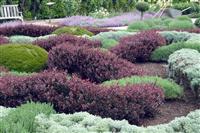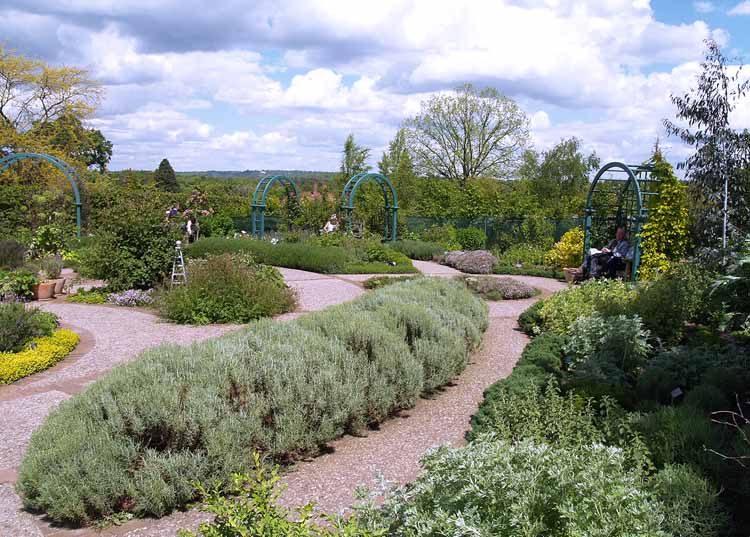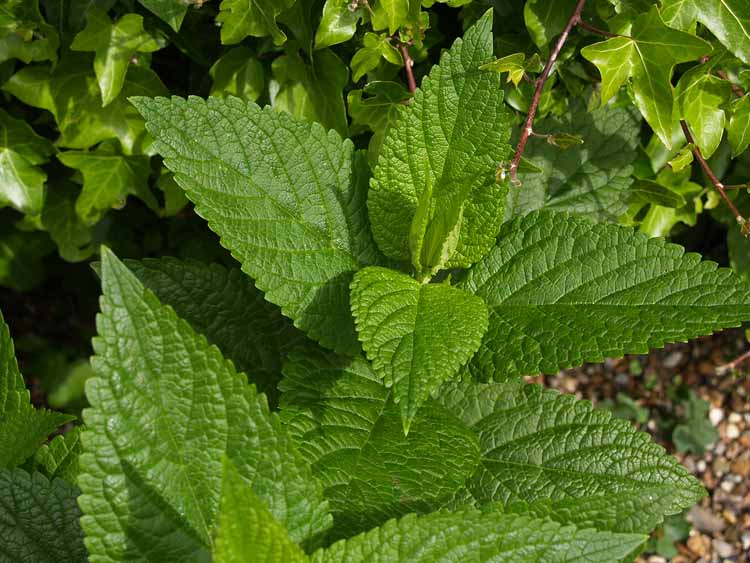HERB Growing
 There are thousands of different herbs grown for culinary, medicinal, aromatic or other practical purposes.
There are thousands of different herbs grown for culinary, medicinal, aromatic or other practical purposes.
Growing and using herbs is a passion for some and a job for others.
This school has been publishing articles, books, videos, and teaching courses on herbs for over 30 years.
Across this and our other web sites you can discover a wealth of unique information and advice.
If your interests go beyond that, you can purchase books through our bookshop that have been reviewed by experts and have confirmed accuracy of information; or you may even go one step further to take a course with us on herbs.
Five things everyone should consider when growing herbs:
1. They are not all the same -some are hardier than others, some need different conditions to others, some need to be treated differently.
2. Most common herbs are relatively hardy, fast growing and like full sun.
3. Get your identification right if using them as a medicine or food. Remember up to a third of all cultivated plants are poisonous to some degree.
4. Many are aggressive and can turn into weeds if not controlled. Unless you plan to put time into maintenance; contain their growth within pots, raised beds or isolated areas.
5. The value (eg. for culinary or medicinal purposes) is affected by the variety grown and stage of growth harvested (eg. not all lavender is the same, and haarvesting at the right time can give you much better quality produce).
 Contents below: (scroll down or click)
Contents below: (scroll down or click)
Recommended Herb Books
Herb Video
Herb Courses
______________________________________________________________________
Herb Videos & Books
VIDEO:
HERB IDENTIFICATION: GETTING TO KNOW HERB PLANTS
 Packed full of information, and covering more than sixty five different herbs, there are three parts to the video. The first explaining what herbs are, where they are grown and how they are used. The concept of companion planting is also explained, with three well proven examples. No dig gardening is then shown through a series of photos taken at stages throughout building and growing. The second part shows how herbs are named and provides a foundation for learning the scientific classification of herb plants. Learn about the main herb families and many of the minor families, and the plants which fall into each. The final part of the tape deals with individual herb plants one by one; what they look like, how they grow, and other characteristics like how to use them.
Packed full of information, and covering more than sixty five different herbs, there are three parts to the video. The first explaining what herbs are, where they are grown and how they are used. The concept of companion planting is also explained, with three well proven examples. No dig gardening is then shown through a series of photos taken at stages throughout building and growing. The second part shows how herbs are named and provides a foundation for learning the scientific classification of herb plants. Learn about the main herb families and many of the minor families, and the plants which fall into each. The final part of the tape deals with individual herb plants one by one; what they look like, how they grow, and other characteristics like how to use them.
Photographs from all over Australia are used, and the information is relevant to all parts of the country. This tape is designed specifically for people who are relatively new to the herb scene. It provides a solid grounding and opens the mind to a wide range of ideas and possibilities. DVD approx. 35 minutes
To order, >>>> click here >>>>
Herb Books reviewed and recommended by staff of ACS: To order, click here.
Growing and Using Vegetables and Herbs is a new book by John Mason
(published in September 2005)
______________________________________________________________________
 Herb Courses
Herb Courses
ACS Distance Education offer a range of courses on Herbs. Click on any course below which you are interested in for more details or to enrol.
certificate-in-herbs-vht014-667
Other Herb Courses offered include:
Aromatherapy >>>>>>
Culinary Herbs >>>>>>
Lavender >>>>>>
Medicinal Herbs >>>>>>
Scented Plants >>>>>>
Certificate in Herbs >>>>>>
Certificate in Horticulture (Herbs) >>>>>>
Advanced Certificate in Applied Management (Herbs) >>>>>>
_______________________________________________________________________
GROWING HERBS NATURALLY
(An extract from notes prepared by staff of the Australian Correpondence Schools)
Most herbs are rapid growers and as such need very fertile conditions if they are to perform at their best. They will respond very well to regular feeding during the growing season, though fertilisers will be wasted if applied when they are dormant. The addition of organic matter in the form of compost and mulch, before and after planting will prove very beneficial. Water is also of great importance to herbs, especially to those grown in pots. In hot weather the soil needs to be kept moist, but not wet. At the height of the growing season, herbs may require watering every day. In general most herbs are relatively pest and disease free, although some plants are prone to specific pests or diseases.
(WARNING: Some herbs can, due to their vigorous nature, become a weed if grown in an inappropriate location).
A FEW SELECTED HERBS
CAYENNE (Capsicum annum)
Annual (Perennial in warmer climates) growing to around 30-40cm tall. Bright green foliage with off-white flowers.
Growing Conditions:
Prefers warm, frost free position, in full to partial shade.
Culture:
Well-drained, moderately rich soil is most suitable. Plants may need staking
Companion Planting:
Grows well with most vegetables. Marigolds and chives nearby may be of some benefit to cayenne.
Propagation:
Seed sown under cover, then seedlings planted out into beds.
Pests & Diseases:
Over-watering can lead to general fungal problems and rotting of the peppers.
Insect damage is rarely a major problem, but can occur.
Uses:
Medicinal and culinary. Variety of pepper that can really 'heat' up a wide variety of dishes. One of the components of cayenne can raise the rate of human metabolism if used regularly. This can result in a greater burn up of calories/joules, aiding in weight loss.
CHAMOMILE - ROMAN OR LAWN (Anthemis nobile)
An evergreen, mat forming perennial, with fine light green , feather-like, divided leaves to 30cm tall, although it is often cut shorter and grown as a lawn.
Growing Conditions:
Grows well in sun or partial shade. Tolerant of frosts and foot traffic.
Culture:
Prefers a moist, but well drained, fertile soil. Build up soil with lots of organic matter before planting. In soils likely to become waterlogged it may be worth installing drainage. A chamomile lawn should have a slope over the surface of at least 1:80 to ensure adequate drainage.
Companion Planting:
Companion plant near onions to improve flavour of onions.
Said to be good beside cabbages, wheat and cucurbits.
As a lawn, chamomile will tend to repel insects.
Propagation:
By seed, division or cuttings.
Pests & Diseases:
Sometimes aphis
Uses:
Culinary and medicinal uses.
Flowers believed to repel fleas, flies and some other insects.
Flowers used in teas, culinary and medicinal.
A tea made from chamomile flowers is also said to help control damping off fungal diseases.
Under the right growing conditions, chamomile makes an attractive lawn which rarely needs mowing.
CHIVES (Allium Schoenoprasum)
Small, bulb forming, lily-like plant to 20-40cm tall, with blue-green ,rounded, hollow stems, and mauve flower balls up to 15 mm diameter.
Growing Conditions:
Full sun or semi shade, open or protected position, temperate to tropical climates.
Culture:
Prefers, well drained, moist, fertile soils. Cut and fertilize regularly. Prefers full sun to partial shade. Frost tolerant.
Companion Planting:
Useful in repelling both air- and soil-borne pests, so may be beneficial to other susceptible plants such as roses, fruit trees, grapes, cucurbits (eg. pumpkin, cucumber), brassicas (eg. cabbage, cauliflower), tomatoes and carrots. Do not plant near beans.
Propagation:
Seed or division.
Pests & Diseases:
Naturally pest and disease resistant.
Uses:
Culinary, medicinal, and repellent properties. Leaves used to flavour savoury foods, such as meats or vegetables, or can be chopped as a garnish (e.g. for herb breads). can also be used as a cut flower. Tea made from chives may have some benefit as a repeated spray against apple scab, and mildews.
CLOVES (Syzygium aromaticum)
Medium to large shrub or small tree from 5-10 m tall, with glossy green, sometimes hairy foliage, and white, pink or red flowers.
Growing Conditions:
Tropics or sub tropics, Full or filtered sun.
Culture:
Prefers a warm, wet, humid position. Soil should contain at least 30% organic material. Dig in ample amounts of compost and rotted manure before planting. Keep well watered during dry periods provided temperatures are over 20 degrees celsius. In cooler conditions, reduce watering. Prune straggly side shoots from young plants.
Propagation:
By seed or cuttings.
Pests & Diseases:
Various insects can damage leaves, otherwise relatively free.
Uses:
Flower buds are dried to provide commercial cloves.
Medicinal and culinary uses, and can be used as a moth repellent amongst clothing.
CORIANDER (Coriandrum sativum)
A hardy annual to 30-60cm, with foliage similar to flat-leaved parsley. Flowers are small and pink, and fruits are small, round balls turning from green to brown as they dry out.
Growing Conditions:
Prefers full or part sun
Culture:
Prefers a moist, fertile, well drained soil. Grow similar to parsley.
Companion Planting:
Companion plant with anise, radish and spinach as the coriander will germinate and develop quicker. Companion plant coriander with potatoes. Do not plant near fennel or roses. Coriander is said to repel aphids, and may be tried as a companion to any plants (not mentioned here) which have serious aphis problems.
Propagation:
Seed in spring
Pests & Diseases:
Uses:
Medicinal, culinary and pot pourri uses. seeds are used to flavour cakes and breads. The slightly bitter leaves are used in Asian cooking.
Oil is used as a medicine for nausea.
Said to help anise seed to germinate.
Attracts bees when in flower.
GARLIC (Allium sativum)
A hardy, clump forming plant to 70cm tall, green to blue-green foliage, and white to pinkish flowers.
Growing Conditions:
Grows best in full sun, but tolerates partial shade. Frost tolerant. Some cold weather (ie. below 10 degrees C) are needed before planting the bulbs (ie. cloves), otherwise foliage doesn't develop properly. Cold weather after planting however, can slow development and reduce the crop. In most places cloves are planted over autumn or winter and harvested 6-9 months later.
Culture:
Prefers a rich, moist, fertile, well drained soil. Grow best in soil which is not too acidic, so add lime when you add compost and manure. The foliage dies back to the roots ('cloves') in cool winter areas and regrow in spring.
Companion Planting:
A good companion plant for most other plants due to its disease repelling feature. Good for apples (for controlling codling moth), other fruit trees (for the control of borers), peach trees (for the reduction on peach leaf curl disease), roses (for protection from black spot and some pests). Beneficial combination with carrots, tomatoes. Garlic is said to be detrimental to strawberries, beans and possibly other legumes..
Propagation:
By dividing the 'cloves' in early autumn or spring.
Pests & Diseases:
Some pests may occasionally damage the leaves but overall, problems are rare.
Uses:
The leaves and roots are high in sulphur, and can be used as a natural anti-biotic in both humans and animals, or as a spray to control fungal diseases on plants. Good herb for repelling mites. Garlic sprays can be effective against many pests and diseases, but should be used fresh for best results (make up the spray and use it immediately).
LAVENDER (Lavandula species)
Hardy, small, perennial shrubs of varying size up to 1 m tall, with foliage green, to bluish grey in colour, and flowers pink, mauve, to purple, occasionally white.
Growing Conditions:
They generally prefer full sun, and relatively low humidity.
Most do best in temperate climates, though some species (e. L. dentata, L. canariensies and L. stoechus) will grow with reasonable success in the humid sub tropics. Most varieties perform better in a protected warm position, although some will withstand cooler conditions.
Culture:
Prefer very well drained, slightly alkaline soils, and may tolerate dry conditions. Moderate fertility is preferable but not essential. Prune after flowering to keep plants in shape. Humidity in warmer climates (with wet summers) can cause mould and fungal problems, so drainage must be excellent and over-watering avoided. Add lime to acid soils or whenever applying manure, compost, mulch or other acidifying materials.
Companion Planting:
May be a useful companion plant with potato to reduce attacks by nematodes. Lavender tends to repel many pests including moths, ticks and rodents. Hedges may be used to border beds of perennials or even vegetables, for both ornamental and repellent affect.
Propagation:
Cuttings of named varieties.
Pests & Diseases:
Few problems. Occasionally caterpillars.
Uses:
Dried flowers are widely used in pot pourri, in lavender sachets and other crafts, or in dried arrangements. The foliage can be dried and used in breads. The oils are widely used in perfumes, other cosmetics, and soaps. L. angustifolia is the commercial source of lavender oil. L. stoechas, the spanish or italian lavender, has a fragrance of camphor and lavender with minty undertones, and is a declared noxious weed in Victoria. L. dentata, the french lavender, produces short, soft-stemmed, plump spikes of dark lavender flowers, and has a strong lavender scent tinged with a light camphor fragrance. Lavender is a good moth repellent. Ornamental shrub, hedge, tub plant.
LEMON GRASS (Cymbopogon citratus)
A semi-hardy clump forming grass to 1.8 m tall in warmer climates, but only to around 1 m tall in cooler temperate areas.
Growing Conditions:
Prefers full sun to light shade. Sensitive to frost, although it can survive milder frosts if well mulched with a bulky material (eg. straw). More suitable to sub-tropical and tropical areas.
Culture:
Prefers a moist, well drained, organic rich soil or compost. One or two applications of compost or manure each year is beneficial. Frequent water in the warmer months will promote rapid growth, although be careful to ensure good drainage. It can tolerate occasional drought in winter. It needs protection from extreme cold in cooler climates (can be grown indoors for some time). May be cut back hard or divided at the end of winter to allow fresh shoots to grow freely.
Companion Planting:
Seems to grow well beside most mint family herbs including lemon balm, mentha and salvia. Useful as a border planting to keep vigorous grasses out of garden beds.
Propagation:
By division of clumps.
Pests & Diseases:
Few. Sometimes rust, grasshoppers, root rots.
Uses:
Leaves are used fresh or dry to make lemon grass tea, and may be harvested at any time of the year. Large plants may be chopped back and the leaves used as a mulch.
You may also be interested in....